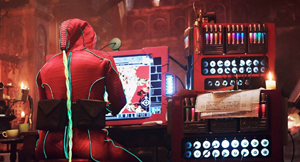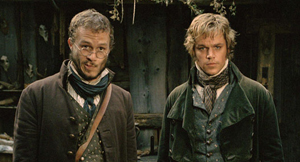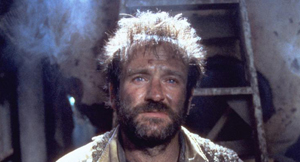In The Zero Theorem, French actress Mélanie Thierry plays Bainsley, who engages with Qohen using virtual reality technology. During production, Gilliam described her as an astonishing combination of Judy Holliday and Marilyn Monroe. The director adds, “When the camera rolls, Mélanie just brightens up. She’s wonderful, she’s really sexy and funny. And when she put on a costume that appealed to her, there was an amazing golden glow coming off her. She’s an extraordinary actor.” The picture’s producer Nicolas Chartier was surprised and delighted with Thierry. He says, “We had a lot of actresses who wanted the part of Bainsley. I wanted a more well-known actress, yet our casting director found Mélanie, and Terry was convinced she was the one. And when I see the movie I can’t believe how right he was. Mélanie is the revelation of the movie, and she will have a big international career after this film.” Thiery is from Yvelines, near Paris. After having worked on French television projects in the late 1990s, Thierry’s first feature film was Giuseppe Tornatore’s LA LEGGENDA DEL PIANISTA SULL’OCEANO/THE LEGEND OF 1900 (1998). Since then, Thierry has performed in a large number of feature films, mainly in French projects, including 15 AOUT/AUGUST 15TH (2001), JOJO LA FRITE/ACCIDENTAL SAINT (2002), ÉCORCHÉS/TWISTED SOULS (2005), CHRYSALIS (2007), BABYLON A.D. (2008), LE DERNIER POUR LA ROUTE/ONE FOR THE ROAD (2009), L’AUTRE DUMAS/DUMAS (2010), OMBLINE (2012), L’AUTRE VIE DE RICHARD KEMP (2013) and POUR UNE FEMME (2013). Thierry received critical praise for her lead role in Bertrand Tavernier’s LA PRINCESSE DE MONTPENSIER/THE PRINCESS OF MONTPENSIER (2010). Since shooting THE ZERO THEOREM, Thierry has taken the lead role in Denys Arcand’s DEUX NUITS (2014).
Mélanie Thierry writes… I’m always very pleased to work in my own country, with wonderful French directors, but it is always delightful to have the chance to cross the border. It’s a new way of working – in a different language, and it’s also a challenge. But the thing wasn’t about working in English on, by the way, a good script. The main thing was to meet, work, and spend time with a man I’d admired for ever, to have the luck to be directed by a master, a mythic person. I have been a huge fan of Terry Gilliam for years and years, and to be a part of this kind of audacious and wacky project was great. Even for a little role, I would have said yes. And for the good surprise, it wasn’t something little, it was the best part I’ve ever had. A character full of life, malice, sweet, playful and funny, and it felt so good to leave all the dramatic roles I’ve had and go to something light. To be directed by Terry was something very intense. He is very demanding: tender but sharp. I did a lot of takes, and I felt a bit guilty in front of Christoph: that he had to give me back the lines sometimes twenty times and maybe even more! After eight takes, I was completely lost. I didn’t understand anything, what was wanted, what was good or bad, I assumed it was once I got lost that Bainsley was alive! I had a lot of dialogue. I prepared in Paris with a dialect coach, but then I was on my own on set, meaning sometimes I was very anxious about words, pronunciation, and rhythm. I was freaking out, but fortunately I had a director who spent a lot of time to reassure me, and a wonderful partner who was very patient. Christoph is someone very mysterious, rigorous, an Austrian gentleman. I was close to a teenage debutante on her first shooting without her mum, but what I kept was the fun. You can’t have no fun and no pleasure when you are on a Terry Gilliam movie! The costumes weren’t easy, maybe the hardest part. The costume designer was great, full of ideas, very creative. But he had no money, and we felt sometimes the deadlock, the impasse. He had to be very clever, with no material, with nothing, yet he succeeded so well. For Bainsley, we needed to find something colourful, sexy, crazy, fun and touching. At the end, I think, it works, but I was again lost with costumes, it was ready the day that the costume played. And one time, for the goodbye scene, I kept my own clothes I got from the morning, I left the hotel at 5am; we had no costume, no time, so I kept my jeans, my shirt, my scarf and my jacket, and we were ready to shoot. All the costumes for the website were great and crazy. But the nurse costume, with the orange shoes, and the pink wig was my favourite, completely Bainsley. The bathing suit was not comfortable but very fun and poetic. The VR suit was my nightmare, I hated this costume, we did the best we can, but even though, it was my “black sheep”. I even tried to cut the scene, but I didn’t achieve it! The water tank? Never again! I have no chance, I’m completely phobic with water. I know how to swim, fortunately. The producers were very worried, but they weren’t at the end of their pain. I can’t put my head underwater, in fact I’d never put my head underwater in a pool, or even in a bath, and don’t even think about the sea. And if my feet don’t touch the bottom, I panic. See what kind of problem I have? The challenge was to go underwater, very deep, open my eyes, say the lines, do not paddle with arms and legs, no bubbles, pretend it was cool, and wonderful, and all of that naked. Preparation helped me, in France with a “waterdancer” she was like a mermaid and she was great with me, and a second one with Romanian stunt guys, who tried to teach me to breathe with diving bottles. I hated it, and I still don’t understand how to breathe underwater. Not for me. After one month and half, ready to shoot, I did it. I did my best, truly, but we still see that I’m like a fish blocking my nose, with my cheeks full of air. We’ll see what kind of miracles the special effects can do! And what was not fair, was to see Christoph doing it very easily, so calm, with such an interior peace, patient, and it was very long in the cold water, very very long, to set up everything. But I made less bubbles! |

Baron Munchausen: Flights of Fancy
A Dreams retrospective by JD Lafrance
















